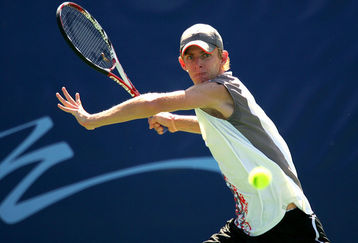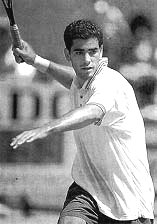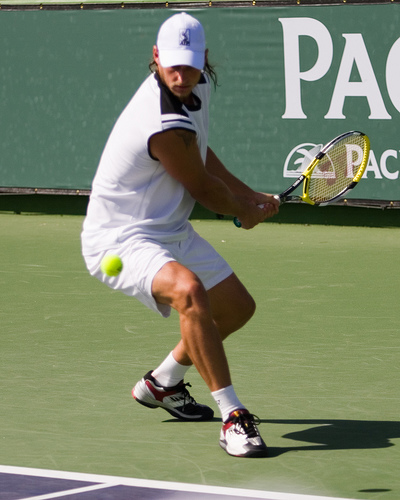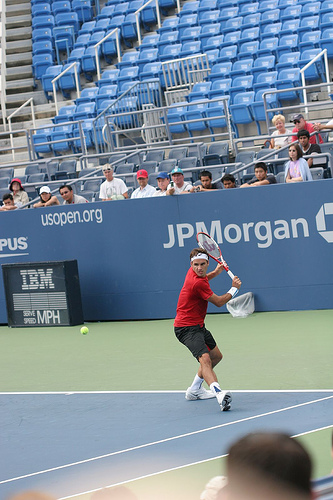One of the elements that all high level tennis players, college tennis players and world class tennis professionals share is efficient and biomechanical sound tennis strokes. In each of these groups, the high level players share commonalities and distinct fundamentals of tennis technique. Although each player should have their own hitting and playing style, they all have basic technical elements in place that separate them from lower level players.
Basic Tennis Technique Foundation
Tennis is a unique game and most tennis players have different looking tennis strokes. No one player hits their tennis forehand or backhand the exact same way nor should they aim to; however, when looking at the tennis technique of top professional players closer through slow motion video, some interesting discoveries about tennis technique can be observed.
There are similarities in fundamental components in tennis technique which are shared by professional players – and these elements are usually not present in players at the recreational, club tennis and sometimes junior levels.
Elements of Tennis Technique
So, what are the key elements of tennis technique that all top professional tennis players and high level tennis players share? What aspects of the forehand and backhand tennis stroke can be broken down, and what are the key fundamentals of world class tennis technique?
- Efficient – The tennis technique or stroke must be efficient, meaning it should get the job done with as few moving parts as possible, while optimally executing the tennis stroke. No hitches, e.g (backswing unneccessarily large, abrupt or rushed takeback, non-fluid swing)
- Adaptable – The tennis stroke, whether it be forehand, backhand or serve must be able to adjust to various conditions, (e.g. bad bounce, windy conditions, late recognition)
- Explosiveness – The tennis technique must include elements in the swing (forehand, backhand or serve) that will deliver good racket head speed and acceleration at contact. Top pros all have very explosive swings, where the racket suddenly accelerates in a very short period of time resulting in phenomenal racket head speed.
How to teach tennis technique
Tennis is an individual sport where there are a variety of different playing styles. Unlike team sports, the development of a player comes down to a person’s own personal intricacies. This large variety in playing styles, tennis technique styles makes it difficult to teach and learn tennis technique.
Some particular tennis technique styles are not suitable for some tennis players, while other tennis players execute best with a certain tennis stroke. But one thing that is hardly ever emphasized at the club and recreational level is tennis technique. It is vital to focus on fundamentals of tennis technique in developing the forehand and backhand tennis strokes. While the player and coach should allow some room for the player’s own unique playing style to emerge, it is key to ingrain the basic fundamentals of tennis technique that will allow a player to improve and experience steady progress in his or her tennis game.
Different tennis strokes and playing styles but same fundamentals
So far we’ve determined that top professional tennis players, college tennis players and high level players all share commonalities in tennis technique. Can we break down these key fundamentals in layman’s terms? The question is, “how can tennis technique be taught without it being confusing or overwhelming?”
The tennis instruction itself must be simple and concise. Great tennis players play in a fluid and natural way, and they are not doing anything overly complicated. They have just learned to develop tennis strokes that are biomechanically efficient which allows them to produce the effortless and powerful forehands and backhands in tennis.
Tennis players that struggle with their tennis strokes often have inefficient swings and unneccessary movement within the motion.
Fundamentals of Forehand Tennis Technique
The forehand can be one of the most complex tennis strokes. There are many key phases in the stroke which make the stroke one of the hardest to master, but mastery of the forehand in tennis is neccessary in today’s baseline game. The game of tennis has evolved into a power game and less finesse as it was in the past. Today, having a good forehand means being able to hit the ball hard with topspin.
It’s becoming more and more difficult to have a one dimensional game in today’s game of tennis. Improving the forehand tennis technique is one area you want to prioritize. Close observation of professional tennis players in slow motion video reveal stunning discoveries about tennis technique.
First, all top forehands in tennis have a “coil” element. Notice how the body is turned sideways, torso is turned and the left arm is straight, somewhat parallel to an imaginary baseline.


Two very different looking forehands, two very different playing styles but startling similar appearance at this critical “set” position.
Second, no matter what tennis technique or tennis stroke style a player has, they manage to deliver the arm and racket slightly in front of the body at contact with the racket face perpendicular. The arm may be slightly bent and the wrist is laid back at contact. The non-dominant hand has rotated to the opposite side as before. Torso position is facing to some degree to the net.


Andre Agassi and Rafael Nadal have completely different looking forehands, yet they both manage to get into the important critical positions at contact, which accounts for why they both have world class tennis forehands.
These types of “key position” similarities are universal in tennis technique where top professional tennis players share these “commonalities” at certain critical positions. These happen so fast, that they are usually missed when observed by the naked eye.
How Does your Forehand Tennis Technique compare?
Now it’s time to take a moment to reflect on your own tennis forehand. How does your forehand tennis technique compare to the pros? Do any of your tennis strokes match the key critical positions highlighted above?
The only way to tell is to have someone video your tennis technique and then review the video to make the comparisons. Or in the rare case, you may have a tennis coach who has a great eye and can see any potential flaws in your own tennis strokes, but seeing yourself on video for the first time can be a humbling experience. You’ll see errors and likely quite visible technical flaws in your tennis technique that can be corrected without even seeking a tennis coach.
Tennis Technique of the Backhand Stroke
So, we’ve seen the tennis forehand stroke and the remarkable characteristics and similarities that world class tennis forehands all share in common. Now, does those same principles of matching “key” critical components apply to the backhand tennis technique and stroke in tennis?
The answer is a resounding Yes. Though the forehand and backhand in tennis are completely different tennis strokes, the concepts behind the fact that all high level tennis players share commonalities in tennis technique still hold true.
Tennis Technique & Preparation Phase of the backhand
Interestingly enough, the backhand tennis technique for both the one-handed backhand and the two-handed backhand both share similar elements particularly in the preparation and (coil) phases. Let’s examine the two-handed backhand first.


As we can see here, Andre Agassi and David Nalbandian have concluded their preparation in this sequence. They do not hit their two handed backhands the exact same way, but the tennis technique is very similar. Notice how the shoulders are turned, center of gravity is low and the deep bend in the knee. The left shoulder is slightly above the right shoulder. It is as if both players are looking down at the ball from their chin. Both Nalbandian and Agassi’s chin is touching their top of their right shoulder indicating a full and complete body turn and coil. Both players are hitting from a closed stance for this particular ball.
Tennis Technique of the One-Handed Backhand Stroke
Let’s take a look at the preparation phase of the one handed backhand stroke. As you will soon see, the tennis technique is quite similar.


Here we have two tennis players, Justine Henin Hardenne and Roger Federer. Both players are in the completion phase of the preparation of their one handed backhand tennis stroke. Again, the tennis technique is very similar. Notice the coil of the body. Shoulders are turned sideways and the upper body coil. Just like the two handed backhand, the technique is similar. Both players have their chin touching their right shoulder indicating a proper turn. Justine Henin’s footwork is also similar to Federer’s. Notice the feet in the closed stance.
The racket position is also similar and the grip is some version of an eastern backhand tennis grip which is the ideal grip to execute the one handed backhand tennis stroke.
Learn more about Tennis Technique
Tennis Technique is a complicated aspect of tennis, but also rewarding when mastery of tennis strokes are achieved. Hopefully you learned a thing or two on this online tennis instructional on the fundamentals of forehand and backhand tennis technique of the top tennis pros.
I cover a lot more in depth detail about the tennis technique and proper tennis strokes & footwork in my tennis ebook, a 60 plus page online tennis instructional ebook in PDF format viewable in Adobe Acrobat. There’s a lot more to learn about tennis technique, hope to see you there!
Learn to Hit a Forehand Like Roger Federer
If you want to jumpstart your forehand and play like the PROS, check out my 70+ page Tennis Ebook that will immediately show you how you can take your forehand to the next level.
The Modern Forehand Domination Ebook is guaranteed to improve your tennis technique, and increase power, topspin and accuracy of your tennis forehand!
Modern Tennis Forehand Ebook
Learn How to Hit a Forehand Like Federer, Nadal and Djokovic

